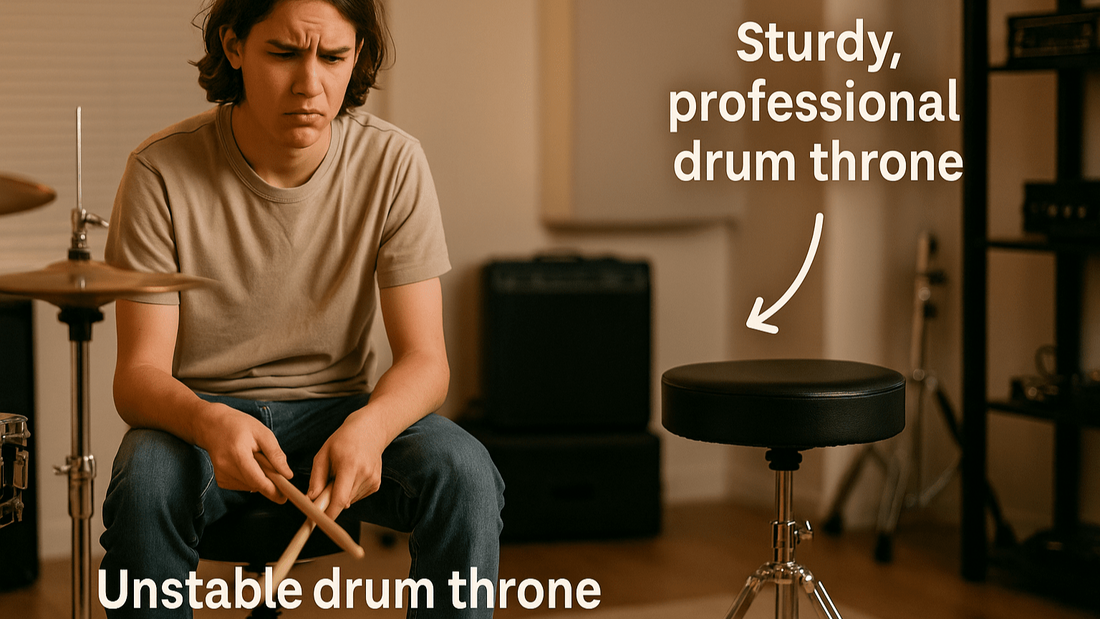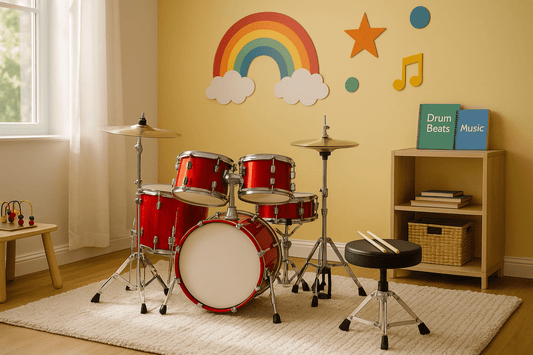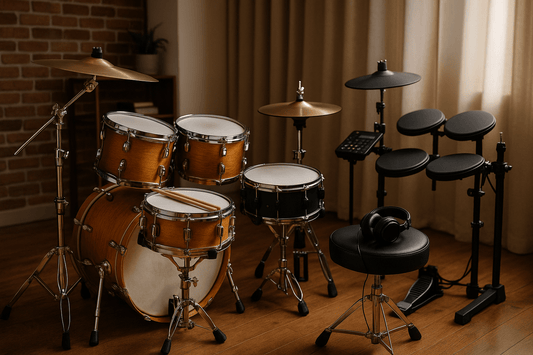Choosing your first drum throne may seem like a small decision—after all, it’s just a seat, right? But here’s the reality: the throne you sit on directly affects your comfort, technique, speed, and even your desire to practice. If you’re constantly shifting, sore, or off-balance, it’s not your kit—it’s probably your seat.
Beginner drummers often overlook the drum throne completely, either using a random chair or choosing the cheapest option available. But that one choice can hold back your progress more than you think.
This article breaks down the most common mistakes beginners make when picking a drum throne and offers simple solutions to help you avoid wasting money, time, and energy. Trust us—getting this right from the start will change the way you play.
Why the Drum Throne Matters More Than You Think
It’s Not Just a Seat—It’s Your Foundation
Imagine trying to run a race with one leg shorter than the other. Sounds ridiculous, right? But that’s what it’s like drumming on the wrong stool. Your throne isn’t just where you park—it’s the center of balance for your whole body. Every stroke, every pedal hit, every motion starts from your seat.
A good drum throne gives you:
-
Balance across your whole kit
-
Support to maintain good posture
-
Comfort for longer practice sessions
-
Stability that keeps your technique clean
Skipping on your throne is like building a house on sand. Your skills might grow—but they won’t last.
Comfort, Control, and Progress All Start Here
When you’re comfortable, your muscles relax. That means cleaner motion, faster speed, and longer endurance. You’re also more focused and confident.
A wobbly, hard, or too-low throne, on the other hand, distracts you. It messes with your timing, kills your concentration, and leaves you sore. Worst of all? It makes you not want to practice.
A solid drum throne doesn’t just support your body—it supports your motivation.
Mistake #1: Choosing Based on Price Alone
The Hidden Costs of Cheap Thrones
It’s tempting to grab the cheapest stool you can find, especially when you’re already investing in drums, sticks, and accessories. But ultra-budget thrones often come with hidden problems:
-
Thin, uncomfortable padding
-
Unstable or wobbly bases
-
Height that doesn’t adjust well (or at all)
-
Materials that wear down quickly
So while you save $30 now, you’ll likely need to replace it in a few months—or suffer through painful sessions that make drumming less fun.
A slightly better investment up front saves you money, time, and back pain later.
What to Look for Beyond the Price Tag
Instead of zeroing in on price alone, ask:
-
Is it height adjustable?
-
Does it have real padding, not just fabric over plastic?
-
Are the legs double-braced?
-
Do reviews mention stability and comfort?
Think of your throne as part of your technique—not just your setup. It should support your practice, not sabotage it.
Mistake #2: Ignoring Adjustability
One-Height-Fits-All Doesn't Work
Every drummer is built differently. Your leg length, torso height, and playing style all affect how you should sit. Yet many beginners buy fixed-height stools—or ones with flimsy, hard-to-use adjustment systems.
A stool that’s too low compresses your hips and limits leg motion. One that’s too high messes with your pedal control and posture. Either way, your playing suffers.
Why Fine-Tuning Is Essential for Growth
Adjustability lets you adapt your seat to:
-
New techniques (like switching from heel-down to heel-up)
-
Growth spurts (especially for teen drummers)
-
Different kits (practice pad vs. acoustic vs. electric)
Even a half-inch height change can affect how your legs feel on the pedals or how your arms reach your snare. Fine-tuning is what separates casual comfort from professional performance.
Mistake #3: Overlooking Stability and Build Quality
Wobble-Free Playing Is Non-Negotiable
A wobbly throne is a confidence killer. One moment you're grooving; the next, you're slipping. Poor stability not only messes up your control—it also increases your risk of injury.
Many beginners think, “I’m not playing live or going wild, so I don’t need something sturdy.” Wrong. Even basic practice requires a solid base.
Features That Keep You Grounded
Here’s what to look for:
-
Double-braced legs: Stronger and more resistant to shifting.
-
Rubber feet: Prevent slipping on smooth floors.
-
Wide tripod base: More surface contact = better balance.
-
Tight locking mechanisms: So your height stays locked in, even under pressure.
If your stool shakes every time you hit the bass drum, you won’t just lose your groove—you’ll lose your patience too.
Mistake #4: Prioritizing Style Over Support
Cool-Looking Isn’t Always Comfortable
That red-stitched, carbon-fiber “racer” drum stool might look awesome, but if it lacks real support, it’s just an overpriced gimmick. Form matters—but not at the expense of function.
Don’t get distracted by flashy finishes, logos, or colors. If it doesn’t feel good after 30 minutes of playing, it’s not helping you.
How to Choose Form That Follows Function
Pick your throne based on:
-
How it fits your body
-
How it holds up under long practice sessions
-
Whether it helps you stay centered and relaxed
Once you find a throne that delivers on function, then you can consider looks.
Mistake #5: Not Trying Before Buying
The Difference 5 Minutes Can Make
You wouldn’t buy shoes without trying them on, right? Same logic applies here. Even if you’re buying online, try to test a few thrones at a local music store. Sit on them. Adjust the height. Wiggle around. Feel the difference in padding.
What seems “fine” at first can become unbearable after just 20 minutes of playing. Or, you might discover a saddle-style seat fits your body better than a round one. These small discoveries can lead to big comfort wins.
What to Check When Testing a Throne
-
Padding comfort: Does it support your weight without sinking?
-
Height adjustability: Can you easily set and lock the height?
-
Stability: Does it shift or wobble as you move?
-
Foot positioning: Can you comfortably reach your pedals?
Five minutes in the store could save you hours of regret later.
Mistake #6: Using Non-Drum Seating
Why Office Chairs and Bar Stools Don’t Cut It
This might be the most common rookie mistake: grabbing a nearby chair instead of investing in a real drum throne. Here’s why it doesn’t work:
-
Office chairs roll and swivel uncontrollably.
-
Bar stools are too tall and usually lack foot support.
-
Folding chairs or dining chairs restrict movement.
None of these options are built for the dynamic movement drumming requires. You end up compensating with bad posture or limited range of motion—which leads to poor habits and even pain.
Drum Thrones Are Designed for Movement
Drum thrones are engineered for balance and freedom. They let you:
-
Shift your weight between pedals
-
Rotate your upper body fluidly
-
Stay aligned during intense fills
If you're serious about drumming—even as a hobby—ditch the kitchen chair and get the throne you deserve.
Mistake #7: Not Considering Playing Style
Rock vs. Jazz vs. Marching Practice Needs
Your drumming style affects what kind of throne is best for you. For example:
-
Rock players who hit hard and move a lot may need more padding and a wider base for stability.
-
Jazz drummers who play light and stay centered might prefer a lower profile or round cushion.
-
Marching band practice often happens on practice pads for long stretches—comfort and posture matter more than style.
Matching your stool to your style enhances comfort and efficiency. It lets you move naturally without working against your gear.
How Your Genre Affects Your Seat Choice
Ask yourself:
-
Do I need to pivot a lot between pedals?
-
Am I seated for long practice sessions?
-
Is portability more important than plushness?
Thinking about how you play helps you decide what to sit on.
Mistake #8: Forgetting About Portability
Do You Need to Carry It to Practice?
Not all drum thrones are created equal when it comes to portability. Some are lightweight and foldable. Others are heavier, with bulky bases and thick padding. If you’re commuting to school band rehearsals or weekly jam sessions, lugging a throne that’s too heavy is a pain.
If your throne needs to travel:
-
Choose one that folds easily
-
Check the weight and dimensions
-
Look for removable seat tops
You’ll thank yourself every time you load in and out of a car or classroom.
Foldable vs. Fixed Thrones
Foldable thrones are great for:
-
Casual players
-
Students
-
Drummers with limited space
Fixed or more heavy-duty thrones are ideal for:
-
Home/studio use
-
Gigging musicians who need stability
-
Taller or heavier players needing more support
Pick one based on your lifestyle, not just your playing style.
Mistake #9: Ignoring Long-Term Use
Plan for Growth—Not Just Now
You might be buying your first drum throne as a beginner, but that doesn’t mean you’ll stay at that level for long. If you're serious about drumming, plan for a seat that can grow with you.
Cheap thrones often break down in a few months. They flatten, start squeaking, or lose their locking mechanism. You end up buying a second stool—then a third. That’s money you could’ve spent on one solid seat from the start.
Investing Once vs. Replacing Often
Ask yourself:
-
Will this still work for me six months from now?
-
Can I use it with a different kit?
-
Is it durable enough for daily practice?
A $90 throne that lasts three years is a better deal than a $40 throne that gives out in six months.
Mistake #10: Overcomplicating the Decision
Focus on Fit, Not Fancy Features
With so many options on the market—saddle vs. round seats, memory foam vs. molded tops, hydraulic vs. spindle—it’s easy to get overwhelmed. Don’t.
At the end of the day, you need three things:
-
Comfort
-
Adjustability
-
Stability
You don’t need a throne that matches your drum color or comes with Bluetooth speakers (yep, that’s a thing). You need a seat that fits your body and supports your playing.
A Simple Stool Can Be a Smart Start
Sometimes the best choice is the one that just works. You don’t have to drop $200. You don’t need the pro-end throne with armrests and air-cushioning.
Start simple, sit correctly, and upgrade later if needed.
How to Choose the Right Drum Throne: A Beginner’s Checklist
Here’s a quick checklist to guide your buying decision:
✅ Is it height adjustable?
✅ Does it have solid padding (not just fabric)?
✅ Are the legs double-braced for stability?
✅ Does it fit your playing style and body type?
✅ Is it comfortable for at least 30+ minutes of playing?
✅ Can you try it out or return it if it’s uncomfortable?
Stick to these basics, and you’ll avoid the 10 biggest mistakes most beginners make. For a more in-depth breakdown of what to look for in a stool and how to avoid every pitfall, read our drum stool buying guide.
Conclusion: Sit Smart from the Start
Choosing a drum throne might not be the flashiest part of your setup—but it’s one of the most important. Your stool impacts your comfort, posture, confidence, and progress. If you're serious about playing well and avoiding injury, it all starts with where you sit.
Avoid the beginner pitfalls. Don’t just grab what’s cheapest or coolest-looking. Instead, find a throne that fits you—your body, your style, your goals.
Sit smart. Play hard. And let the music flow.
FAQs
Is it okay to start on a basic drum throne?
Yes, as long as it's adjustable and offers solid support. Just avoid chairs not made for drumming.
What’s the biggest sign I need a new stool?
If you're feeling sore, off-balance, or constantly adjusting mid-session, it’s time for an upgrade.
Can a bad throne cause injury?
Absolutely. Poor posture leads to back, wrist, and hip strain over time. A good throne reduces that risk.
Should I upgrade my throne or drum kit first?
If your kit works but your seat is uncomfortable, upgrade the throne first. Comfort improves everything.
How much should I really spend as a beginner?
Aim for $60–$100. That range offers a great balance of quality, comfort, and adjustability for starters.




